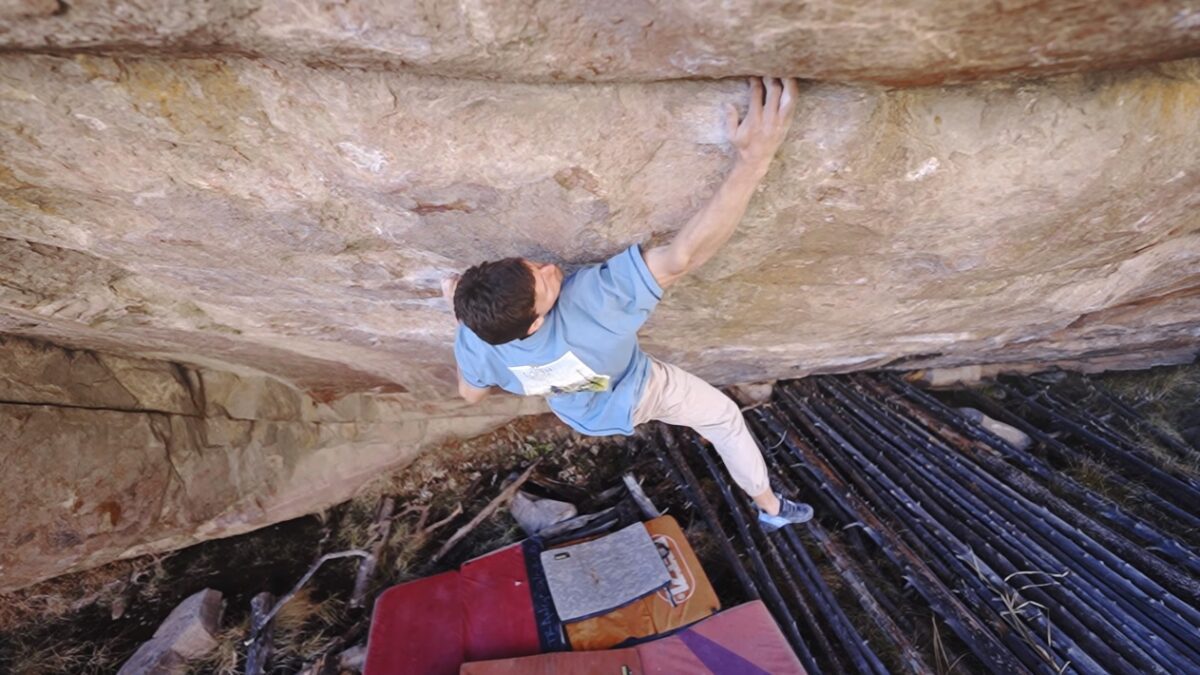Nathaniel Coleman Talks Sending Defying Gravity V15
The Olympic silver medalist shares his thoughts on projecting the legendary climb, what he learned from the process, and that notoriously difficult first move
 Photo by: Ben Neilson
Photo by: Ben Neilson
Nathaniel Coleman recently made the fourth ascent of Daniel Woods’ Defying Gravity V15. Located in Thunder Ridge, Colorado, Defying Gravity is a wildly dynamic problem that features one of the single hardest starting moves in the world.
Clocking in at around V14, the problem’s first move is a coordinated throw to a glassy rail. A few different methods have been discovered for sticking the rail, but each one is as difficult as the next. After moving to a higher set of edges, a huge, shouldery double-digit deadpoint follows – with climbers cutting feet and coiling their body into a Janja-esque scorpion in order to hold the position.
A few days after Woods climbed Defying Gravity back in 2013, Jimmy Webb made the second ascent. The problem then went unrepeated for nearly 10 years until Noah Wheeler made the third ascent last month. Coleman’s fourth ascent is featured in a newly released film from Mellow, which you can watch below.
Defying Gravity is another proud tick on Coleman’s climbing resume. On top of his comp climbing accomplishments, Coleman has sent some of the very hardest climbs in United States including Grand Illusion V16 and Empath 5.14d/15a. To learn more about his repeat of Defying Gravity, I reached out to Coleman. You can read our short interview below.
What unlocked that first move for you? In the video, you mention trying to be as static as possible.
There were a few key pieces of beta that Jimmy shared with us. First, keep the heel on for as long as possible, and pull your hips into the wall when you generate. Both of these ideas become intuitive when you try to do the move “static”. Then once you stick the first hold, pull more outwards than downwards with your right hand to help your left hand stay on the start hold as long as possible. I found that as I perfected the move more and more, I was able to keep my left hand through the whole swing, which was a real blessing after the left part of the upper rail broke, as you see in the video.
Other climbers have called the first move a single-move V14 and then the huge deadpoint above a V10. Do you agree with that assessment?
I think it’s an accurate assessment. I can’t speak to Daniel’s beta, but the way I did the first move felt far harder and more complex than any other move I’ve ever tried. The second jump move including two set up moves clocks in around V11. It’s a very committing and fast move to a slot, so it’s very accurate as well. I think these two moves in combination make the boulder ultra low percentage. If the move order was switched, I think the boulder would be V16, at least.
What is the rail like that you’re shooting to in that first move?
The rock on Defying Gravity is incredibly bulletproof and textureless. When I first saw the boulder, I thought if I knew nothing about it I would estimate it to be V13. The starting holds are at least 20 mm and flat relative to the wall, and the hold you’re jumping for is probably 30 mm and slightly incut with a helpful thumb catch. If the holds had sandstone texture, the boulder would probably drop in difficulty by three or four grades.
Did you ever fall after sticking the first move?
Thankfully, no.
On your send go, after sticking the opening sequence, were you feeling confident about the upper crux? Did you have that sequence dialed?
I had rehearsed the upper sequence multiple times every day I tried the boulder, so I did feel very confident in my ability to stick it. As soon as I did the first move I was in a state of disbelief, and I considered stopping to collect myself. But I’m glad that I decided to just move quickly and let muscle memory take over. Once I stuck the second jump move, I was able to relax a bit and enjoy the final length of climbing.
What’s next for you? Other boulders? Routes?
Since coming home to Salt Lake it’s been a great season in Little Cottonwood Canyon, and currently I’m trying to repeat Sean Bailey’s new Doors of Perception V15. I also have my eyes on Trieste V14 in Red Rocks and a project in Southern California that Taylor McNeil invited me to try with him. In January/February, Sean Bailey and I will go back to the $6 Million Man project that we’ve been trying for a few years now to see if our luck has gotten any better.
Do you feel like you’ve learned anything from the process of projecting Defying Gravity?
Defying Gravity taught me a lot about patience and tactics. To learn the first move, me and Charlie Barron would give each other power spots with less and less assistance as needed. I’ve been using this tactic on other boulders as a way to conserve energy while gathering a lot of information about how to improve on any given movement, and it’s made the process of progress much smoother. Also, after projecting one move for eight days, I don’t worry when a new move doesn’t come together on the first few sessions. I focus instead on the things I’ve learned about the move, and there’s an underlying sense of confidence that sooner or later, that move will be mine.


